How to Choose Futures Fins - The Choice of Pros and Amateurs Alike
Share
Futures Fins are renowned for their leading removable fin systems, consistently chosen by professional and recreational surfers globally for their quality and performance.
The single, comprehensive fin box is easy to use and provides adequate support to prevent broken fin bases, and the wide variety of available models provides options for all styles and sizes of riders and waves.
Future has signature fins from many of the industry’s top shapers and surfers, including Al Merrick, Dan Mann, Eric Arakawa, Hayden, Pyzel, Matt Biolos, Tomo, John John Florence, Jordy Smith, Dave Rastovich, and Rob Machado. It also has a number of different construction options with different advantages, such as Blackstix, Honeycomb, TechFlex, Control Series, and Legacy Series.
The different fin sets are available in a number of different sizes as well, with X-SMALL fins are ideal for groms and super lightweight surfers weighing between 75 to 115 pounds, providing optimal performance for their size, SMALL working for surfers between 105 and 155 pounds, MEDIUM working for mid-weight surfers 145 to 195 pounds, and LARGE fins being appropriate for surfers who are 180 pounds and above.
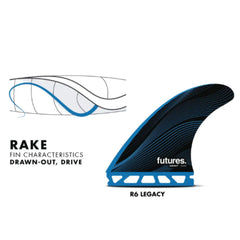 |
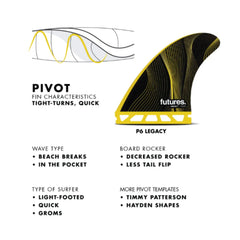 |
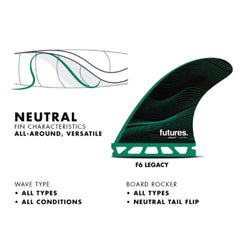 |
Futures Fins are categorized into three distinct shapes: rake fins for extra drive, pivot fins for tighter turns, and neutral fins for a balanced ride Rake fins having a more drawn back design (providing extra drive), pivot fins being less drawn back and more upright (providing a looser feel and a tighter turn radius), and neutral fins finding a balance in the middle.
The innovative ride number system simplifies fin selection, with lower numbers for control and higher numbers for speed and responsiveness. Future Fins have a ride number that ranges from 1 to 10, with the lower numbers providing more control and the higher numbers providing more speed and responsiveness.
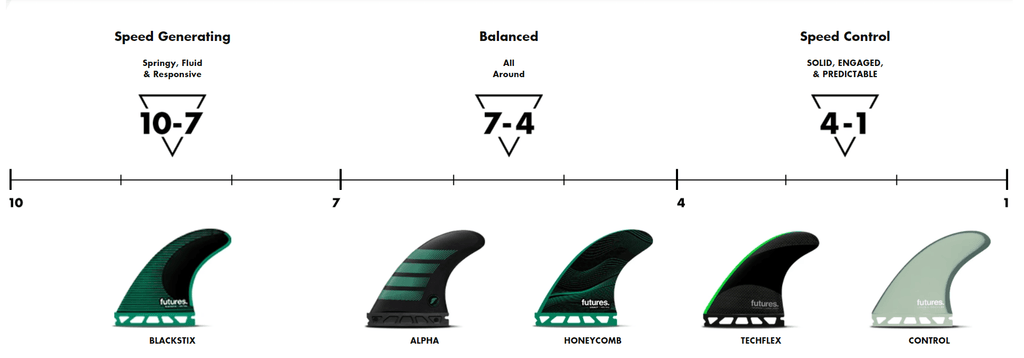
The Speed Generation fins (10-7) are best for small to medium waves where you need to generate speed and want to increase performance. The inside edge of the fins is scooped out slightly like an airplane wing (this is called a vector), which adds lift for down-the-line speed and also provides additional flex. This vector is obviously very helpful in smaller, less powerful waves, but tends to stick in larger, hollower waves.
The Balance fins (7-4) include the Performance Core and Vector (carbon fiber)fin lines (not to be confused with the vector inside edge of the Speed Generation fins) have flatter foil and tend to be stiffer, which makes them great for heavier surfers or those who provide their own power and speed, but who still want some release during their turns.
Finally, the Speed Control (4-1) range of fins is quite stiff (typically made of carbon fiber or fiberglass) and is designed for increased control at high speeds and in heavy, powerful waves of consequence.
| Flex | Rake | Foil |
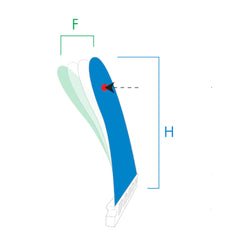 |
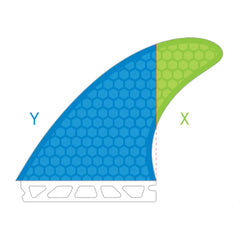 |
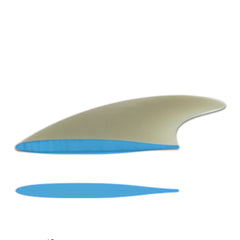 |
As you can see, there are a lot of factors to take into consideration when selecting fins for your boards with Future boxes. That being said, if you know what style of surfing you do and what type of waves you typically ride, it becomes quite a bit easier to select the right fins for the day. And the ability to change fins based on the conditions has the added effect of making your boards more adaptable, effectively increasing the size of your quiver without having to buy more surfboards.
SHOP FUTURES FINS NOW!
We answer some of the common questions asked about the Futures Fins:
1. What makes Futures Fins unique compared to other fin systems?
Futures Fins feature a single, comprehensive fin box that is easy to use and provides adequate support to prevent broken fin bases. This system is trusted by both professional and recreational surfers worldwide.
2. Who are some of the industry shapers and surfers that have signature fins with Futures?
Notable names include Al Merrick, Dan Mann, Eric Arakawa, Hayden, Pyzel, Matt Biolos, Tomo, John John Florence, Jordy Smith, Dave Rastovich, and Rob Machado.
3. What are the prices of most futures fins?
You can check out our collection page and see what futures fin model best suits your preference, the available price is displayed upon viewing selected items.
4. How do I choose the right size fin for my weight?
Futures Fins are available in different sizes: X-SMALL for surfers between 75 to 115 pounds, SMALL for those between 105 and 155 pounds, MEDIUM for surfers 145 to 195 pounds, and LARGE for those who are 180 pounds and above.
or Check this blog for more info...
5. What are the different categories of Futures Fins based on their shape?
Futures Fins are categorized into rake fins (for extra drive), pivot fins (for a looser feel and tighter turn radius), and neutral fins (balancing the two).
6. What is the Ride Number system, and how does it work?
The Ride Number system ranges from 1 to 10, with lower numbers providing more control and higher numbers offering more speed and responsiveness. It helps surfers choose fins based on the feel they prefer: Speed Generating (10-7) for responsiveness, Balanced (7-4) for a mix of control and flexibility, and Speed Control (4-1) for stability in powerful waves.
7. Which fins should I choose for small to medium waves?
Speed Generating fins (10-7) are recommended for small to medium waves, as they help generate speed and increase performance thanks to their vector inside edge that adds lift and flex.
8. What are Balanced fins, and who should use them?
Balanced fins (7-4) have a flatter foil and tend to be stiffer, making them ideal for heavier surfers or those who can generate their own power and speed but still want some release during turns.
9. What are Speed Control fins, and when should they be used?
Speed Control fins (4-1) are quite stiff and designed for increased control at high speeds and in heavy, powerful waves, making them suitable for surfing in challenging conditions.
10. Can I change Futures Fins based on the surfing conditions?
Yes, the ability to change fins based on conditions makes your boards more adaptable, allowing for a more versatile surfing experience. These questions and answers should provide a comprehensive overview for anyone looking to understand more about Futures Fins and how to select the right ones for their surfing needs.
More to Read...
👉How To Choose The Right FCS II Fins By Hawaiian South Shore
